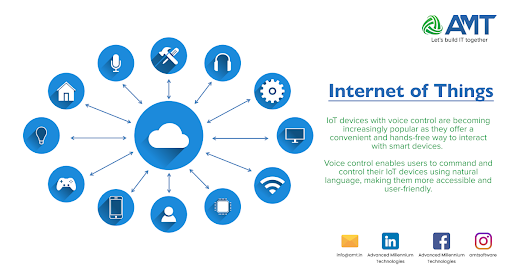IoT (Internet of Things) devices with voice control are becoming increasingly popular as they offer a convenient and hands-free way to interact with smart devices. Voice control enables users to command and control their IoT devices using natural language, making them more accessible and user-friendly. Here are some common examples of IoT devices that incorporate voice control:
- Smart Speakers: Smart speakers like Amazon Echo with Alexa, Google Home with Google Assistant, and Apple HomePod with Siri have built-in voice control. They serve as central hubs for controlling various IoT devices in your home, such as lights, thermostats, and smart locks.
- Smart Thermostats: Thermostats like the Nest Thermostat or ecobee have voice control features, allowing you to adjust the temperature using voice commands. For example, you can say, “Hey Google, set the temperature to 72 degrees.”
- Smart Lighting: Smart bulbs and lighting systems from companies like Philips Hue or LIFX can be controlled via voice. You can turn lights on and off, change colors, and adjust brightness using voice commands.
- Smart Locks: Some smart locks, such as the August Smart Lock Pro, are compatible with voice assistants. You can lock and unlock your door with a simple voice command after setting up the integration.
- Smart TVs and Streaming Devices: Many smart TVs and streaming devices, such as Roku or Fire TV, support voice control for functions like changing channels, searching for content, and adjusting the volume.
- Smart Appliances: Some kitchen appliances like smart ovens and refrigerators may offer voice control features. For example, you can preheat your oven or check the contents of your refrigerator by voice command.
- Smart Cameras: Voice control can be integrated into home security cameras, allowing you to view camera feeds and control camera settings using your voice.
- Smart Home Hubs: Smart home hubs like Samsung SmartThings and Hubitat Elevation often have voice control integration, enabling you to manage and automate various IoT devices.
- Smart Shades and Blinds: Motorized window shades and blinds can be controlled with voice commands to open or close them, adjust the level of light, or set schedules.
- Voice-Controlled Assistants: Besides the aforementioned dedicated IoT devices, you can also use voice assistants like Amazon Alexa, Google Assistant, or Apple Siri on your smartphone or tablet to control a wide range of IoT devices through voice commands.
Keep in mind that voice control may require setting up integrations or skills, and compatibility with specific voice assistants can vary between devices and manufacturers. Also, it’s essential to consider privacy and security when using voice-controlled IoT devices, as they typically require a continuous listening mode to respond to voice commands.
Here are more examples of IoT devices with voice control:
- Smart Window Curtains and Blinds: Motorized window curtains and blinds, such as those from Somfy or Serena by Lutron, can be controlled using voice commands to adjust the level of natural light in your home.
- Smart Sprinkler Systems: Voice control can be integrated into smart sprinkler systems like Rachio, allowing you to schedule and adjust watering times for your lawn and garden with voice commands.
- Smart Fans: Some ceiling fans and standalone fan units, like those from Hunter or Haiku, come with voice control capabilities, enabling you to control fan speed and direction with your voice.
- Smart Vacuum Cleaners: Robotic vacuum cleaners like the iRobot Roomba and Neato Botvac can be controlled using voice commands to start, stop, or schedule cleaning tasks.
- Smart Home Security Systems: Home security systems like SimpliSafe may have voice control features for arming and disarming the system, as well as checking the status of sensors and cameras.
- Smart Outdoor Lighting: Voice-controlled outdoor lighting systems, like Philips Hue Outdoor, can help you control and customize the lighting in your outdoor spaces.
- Voice-Controlled Mirrors: Some smart mirrors with integrated voice assistants allow you to check the weather, get news updates, and control other smart devices while getting ready in the morning.
- Voice-Controlled Kitchen Appliances: Certain kitchen appliances, such as microwave ovens and coffee makers, can be voice-controlled, making it easier to cook and prepare your favorite dishes.
- Voice-Activated Wearables: Some wearable devices, like smartwatches and fitness trackers, offer voice control to help you send messages, set reminders, or interact with other IoT devices on the go.
- Voice-Controlled Cars: Voice-activated infotainment systems in modern vehicles enable drivers to control navigation, make calls, and adjust climate settings while keeping their hands on the wheel.
- Voice-Activated Health and Wellness Devices: IoT devices such as smart scales and blood pressure monitors may support voice commands to track and monitor your health metrics more conveniently.
- Voice-Controlled Pet Devices: For pet owners, there are IoT devices like pet feeders and cameras with voice control that allow you to remotely dispense treats or check in on your pets when you’re away from home.
- Voice-Controlled Home Theater Systems: Home theater enthusiasts can use voice control to operate AV receivers, control home theater lighting, and launch streaming apps on smart TVs.
- Voice-Controlled Irrigation Systems: Smart irrigation controllers like RainMachine can be controlled with voice commands to manage your garden’s watering schedule.
- Voice-Activated Education and Learning Devices: IoT devices for education, such as interactive whiteboards and educational robots, may incorporate voice control features for a more interactive learning experience.
Remember that voice control compatibility and functionality can vary depending on the device’s brand, model, and the voice assistant you are using (e.g., Alexa, Google Assistant, Siri). It’s essential to check compatibility and set up integrations for the specific devices you want to control via voice.
